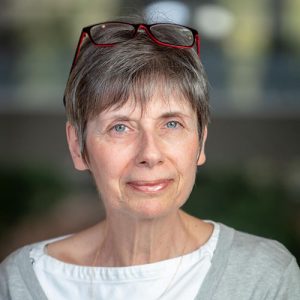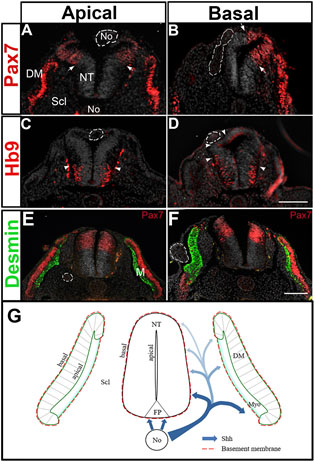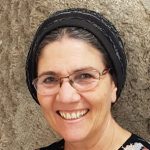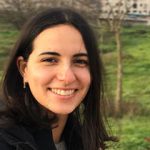
Our laboratory aims at elucidating basic processes taking place during embryonic development of the nervous and musculo-skeletal systems. We focus on four main subjects: first, the development of the peripheral nervous system (PNS) from the neural crest. Second, the cellular and molecular basis underlying the transition from the neural crest state (PNS) to the definitive roof plate of the CNS. Third, morphogens and mechanisms involved in muscle and vertebral development. Fourth, the molecular signals that mediate interactions between mesoderm and nervous system, found to be of significance for patterning and differentiation.Our lab has a rich academic record in avian embryology and molecular techniques that include in ovo microsurgery and grafting, targeted gene missexpression in embryos, in vitro explants and culture systems, imaging and RNAseq techniques.
We are currently interested in elucidating the mechanisms leading to the end of Neural Crest production and emigration and the concomitant transition into the Roof plate of the dorsal CNS domain.
In addition, we pursue experiments to understand the patterning of skeletal muscles and vertebrae, and the roles of morphogens such as Sonic hedgehog, etc in coordinating skeletal with neural development.
Our work focuses on avian embryos (chick and quail) and includes a variety of in vivo techniques, from tissue grafting to gene missexpression, in vitro explants, molecular profiling and imaging. We actively collaborate with researchers in the mammalian field to complement our knowledge using genetic models.
Research on the development of the dorsal neural tube is particularly challenging. In this highly dynamic domain, a temporal transition occurs between early neural crest progenitors that undergo an epithelial-to-mesenchymal transition and exit the neural primordium, and the subsequent roof plate, a resident epithelial group of cells that constitutes the dorsal midline of the central nervous system. Among other functions, the roof plate behaves as an organizing center for the generation of dorsal interneurons. Despite extensive knowledge of the formation, emigration and migration of neural crest progenitors, little is known about the mechanisms leading to the end of neural crest production and the transition into a roof plate stage.

image from: Rekler, D. and Kalcheim, C. (2021). From Neural Crest to definitive Roof Plate: the dynamic behavior of the dorsal neural tube. Int. J. Mol. Sci.
The sonic hedgehog (Shh) protein plays fundamental roles in the development of the neural tube (NT) and somites. Following neurulation, Shh secreted by the notochord (No) induces distinct ventral cell identities in the overlying NT by a mechanism that depends on relative concentrations and duration of exposure. Moreover, the activity of Shh continues beyond this stage to regulate cell proliferation, survival and differentiation. No-derived Shh is also involved in mesoderm patterning.
In our lab we investigate the mechanisms of action of Shh in neural and mesodermal development.

image from: Kahane, N. and Kalcheim, C (2020). Neural tube development depends on notochord-derived Sonic hedgehog released into the sclerotome. Development.
Our lab has been generously supported over the years by the Israel Science Foundation, DFG, IMRF, March of Dimes, ICRF and Familial Dysautonomia Foundation.
Rekler, D. and Kalcheim, C. (2022). Completion of neural crest cell production and emigration is regulated by retinoic-acid-dependent inhibition of BMP signaling. eLife.
In this paper we reveal a role for neural tube-derived Retinoic Acid in ending the neural crest production. Retinoic acid acts through BMP signaling to downregulate neural crest-specific genes and to stop cell emigration from the neural tube. While it is also important for aspects of the development of definitive Roof Plate, not all Roof Plate traits depend on retinoic acid, suggesting that the end of neural crest production and the formation of the Roof Plate are in part independently regulated.
Ofek, S, Wiszniak, S, Kagan, S, Tondl, M, Schwarz, Q, and Kalcheim, C. (2021). Notch signaling is a critical initiator of roof plate formation as revealed by the use of RNA profiling of the dorsal neural tube. BMC Biol.
In this article we used RNA-seq to reveal differences in gene expression profile between Neural Crest and definitive Roof Plate cells. Based on these findings we proceed to show the importance of Notch signaling in the formation of the definitive Roof Plate of the spinal cord and highlight its role in the segregation between Roof Plate and dorsal interneurons.
Kahane, N. and Kalcheim, C (2020). Neural tube development depends on notochord-derived Sonic hedgehog released into the sclerotome. Development.
Recommended by Faculty Opinions (F1000).
In this article we reveal a role of the sclerotome as a site of Shh gradient, controlling development of mesodermal and neural progenitors.

Research associate
Early development of somites and muscles, and recently also ribs and vertebrae

Ph.D student
I am interested in the transition between the Neural Crest and the definitive Roof Plate in the developing nervous system.

MD-Ph.D student
The involvement of Delta-Notch signaling in roof plate development and in roof plate-interneurons border formation.

MSc student
Early development of the neural tube

undergraduate student
Examining the effects of Shh deprivation in avian embryos using electroporation of mutated genes.
Website designed by toornet
1973-1977: B.Sc. degree, Faculty of Life Sciences,Hebrew University of Jerusalem. Subjects: Physiology.
1977-1979: M.Sc. degree in Neuroendocrinology under the supervision of Prof. Y. Koch, Dept. of Hormone Research, The Weizmann Institute of Science, Rehovot.
1980-1984: Ph.D. degree under the supervision of Prof. Z. Vogel, Dept. of Neurobiology, The Weizmann Institute of Science, Rehovot.
Sept. 1984- Post-doctoral training in the laboratory of Prof. N. Le Douarin, Institut
Dec. 1986: d’Embryologie du C.N.R.S. et College de France, Nogent Sur Marne, France.
Jan. 1987- 1991 Lecturer in the Department of Anatomy and Embryology, Hebrew University- Hadassah Medical School. Jerusalem.
1992-1996 Senior Lecturer-
1996-2000 Associate Professor.
2001 – Present Professor. Department of Medical Neurobiology, IMRIC and ELSC-
2010 – Present Member of the ELSC, the Edmond and Lili Safra Center for Neurosciences of the Hebrew University.
My PhD was in HUJI in the field of cellular biology, specifically investigating RNA splicing. After that for the last thirty years I have been working with Prof. Chaya Kalcheim.
I’m married and have ten children.
1994-1996: BSc in Biology, The Hebrew University of Jerusalem, Israel.
1997-2000: MSc in Microbiology, The Hebrew University of Jerusalem, Israel. MSc thesis: “Biological activity of multi drug resistance (MDR) inhibitors”.
2001-2007: PhD: The Hebrew University of Jerusalem, Israel.Research thesis: “Rab4 controls basolateral exocytosis in polarized epithelial cells”.
2008-2012: Post-Doctoral position: Department of Clinical Microbiology and Infectious Diseases, Hadassah Hebrew University Medical Center. Major research subjects: 1) Studying the Mechanism of Amphotericin B toxicity and activity and its toxicity neutralization by conjugation to Arabinogalactan. 2) Discovery of novel anti-biofilm compounds and investigating their mode of action.
I did my B.Sc in Biomedical Sciences in the Hebrew University, and continued to pursue a Ph.D in Chaya Kalcheim’s lab. I am excited about developmental biology and play tennis in my spare time.
I’m Doing my Ph.D in Chaya Kalcheim’s lab in the M.D-Ph.D program. In my free time, I scuba dive and practice freediving. I hope I will combine emergency care medicine and neuroscience research in the future.
I am from Trieste, Italy and I just concluded my Bsc in Neuroscience with Psychology at the University of Aberdeen in Scotland. I am currently studying a Master in Medical Neuroscience at the HUJI in Jerusalem. Some of my hobbies include playing the guitalele, a hybrid between the guitar and the ukulele, drawing some abstract art, taking photos, as well as writing poetry!
MD student. Love listening to music from the 70′. Full name- Yael Zohara Barda.